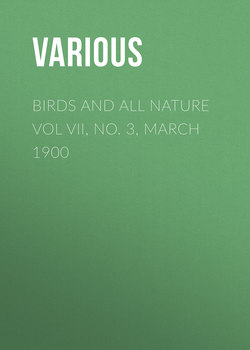Читать книгу Birds and all Nature Vol VII, No. 3, March 1900 - Various - Страница 7
THE WILLOW PTARMIGAN
Оглавление(Lagopus lagopus.)
C. C. M
IT has been claimed by some ornithologists that this species of grouse is not to be found in this country, but it is now well established that it may be found in northern portions of New Hampshire and northern New York. In summer it is distributed throughout Arctic America. It breeds abundantly in the valleys of the Rocky Mountains on the Barren Grounds and along the Arctic coasts. Davie, who is probably the best authority we have, says that the winter dress of this beautiful bird is snow white, with the central tail feathers black, tipped with white. In summer the head and neck are yellowish red, back black, barred rather finely with yellowish brown and chestnut, although the most of the wings and under parts remain white as in winter. Large numbers of the willow ptarmigan are said in the winter to shelter in willow thickets and dwarf birches on the banks of lakes and rivers, where they feed on the buds of the smaller shrubs which form their principal food at that season. Their favorite resorts in day time are barren, sandy tracts of land, but they pass the nights in holes in the snow. When pursued by sportsmen or birds of prey they dive in the loose snow and work their way beneath its surface.
Nests of this species have been found in the Anderson River region early in June and as late as June 24. Others have been found on the banks of the Swan River as late as June 27. One nest was observed July 10 which contained ten perfectly fresh eggs, and another set of eggs was examined July 22, the contents of which were slightly developed. The nests were mere depressions in the ground, lined with leaves, hay, and a few feathers from the birds themselves. These birds often occupy the same nest in successive seasons. Ten eggs are usually laid, though the female is said to lay as many as sixteen. The eggs have a ground color varying from yellowish buff to deep chestnut-brown, more or less sprinkled, speckled, spotted, or marbled with rich brown or black. The average size is 1.78 by 1.25.
Hallock says that the various species of ptarmigan are all Alpine birds, and are only found in the North and on the highest mountain ranges. They are to be distinguished from all other members of the grouse family by the dense feathering of the tarsus and toes, by turning white in winter and by the possession of only fourteen tail feathers. The bill is very stout and the tail always black. The length of the ptarmigan is about sixteen inches. It is a most delicious article of food, whether roasted, stewed, or in white soups. It is said that visitors to Newfoundland assert that the flavor of a plump partridge, well cooked, is unsurpassed in richness and delicacy. A brace of them in season weigh from three to three and a half pounds. On the first of September they are in prime condition, after feeding on the wild partridge berry and cranberry, their favorite food.
When on the wing it is said the scarlet tips over the eyes of the male bird glisten like rubies. The cock exposes himself fearlessly, when in danger, to save the lives of his offspring. He tumbles along the ground a few yards in advance of the dogs, rolling there in order to decoy the sportsman from the brood which the hen is anxiously calling into the thicket. No more touching instance of paternal affection could be witnessed, or more touching proof among the lower creation of self-sacrifice, prompted by love. The poor, feeble bird would almost attack dogs and men in his efforts to save his children.
At times, in some districts, the ptarmigan is so tame that it can be killed with a stick, and at others so wild that it will not allow the sportsman to approach within gun shot.
